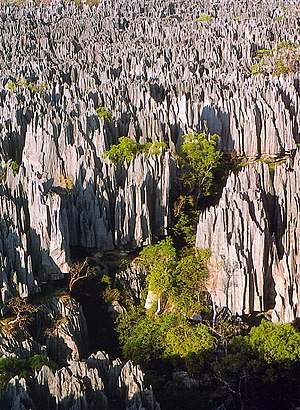Tsingy De Bemaraha
National Park
The southern end of the protected area was changed into the Tsingy de Bemaraha National Park in 1997, while the northern end of the protected area remains as a strict nature reserve (Réserve Naturelle Intégrale). Borders were most recently adjusted in 2011.
It is characterised by needle-shaped limestone formations, above cliffs over the Manambolo River. The incredibly sharp limestone formations can cut through equipment and flesh easily, which makes traversing them extremely difficult. The word "Tsingy" is derived from a local word meaning "the place where one cannot walk barefoot".

Tourism
Tourists can access the national park by road from Morondava, a town 150 km south of the park. Limited access is also possible from the town of Antsalova, which can be reached by plane from Antananarivo or Mahajanga.
See also
- List of national parks of Madagascar
- Madagascar dry deciduous forests
- Penitente (snow formation)
- Tsingy de Bemaraha National Park
- World Heritage Sites in Madagascar
- Manambolo River
References
- ^ "Tsingy de Bemaraha Strict Nature Reserve". UNESCO. Retrieved 2009-11-01.
- ^ Shea, Neil (November 2009). "Living On a Razor's Edge: Madagascar's labyrinth of stone". National Geographic. Archived from the original on October 22, 2009. Retrieved 2009-11-01.
- ^ "21 World Heritage Sites you have probably never heard of". Daily Telegraph.
